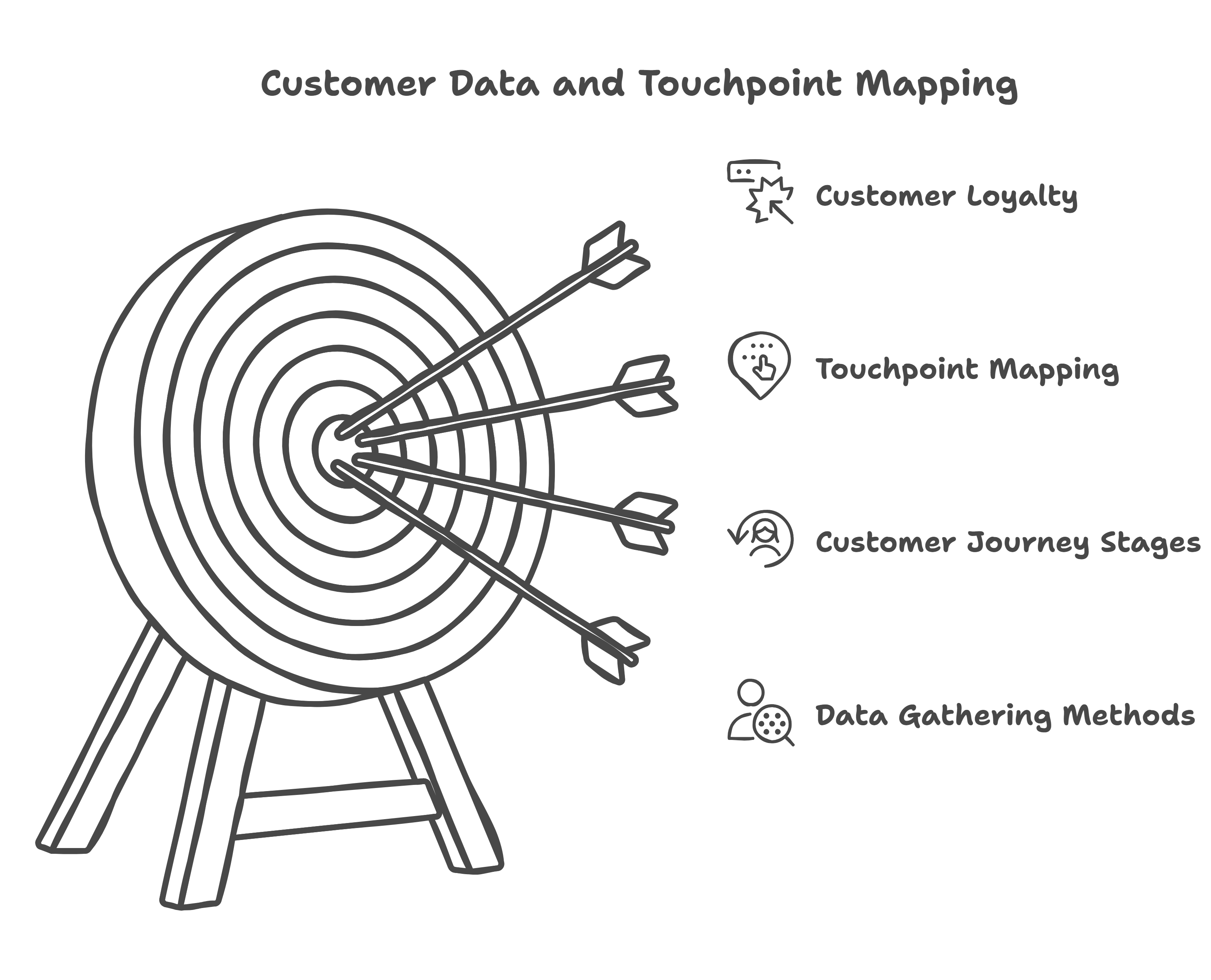Data & Touchpoints: Gathering Insights & Mapping Customer Interactions
Data Gathering Methods
To effectively market to your audience, you must first gather data, which is available from all kinds of primary and secondary sources:
-
Methods to Gather Data:
-
Surveys: Collecting structured feedback from customers through questionnaires.
- Simple Explanation: Asking customers to fill out a form with questions about their satisfaction, preferences, etc.
- Real-life Example: Amazon regularly sends out surveys to its customers asking about their shopping experience, product satisfaction, and suggestions for improvement.
-
Interviews: Conducting one-on-one conversations with customers to gain deeper insights.
- Simple Explanation: Meeting people to ask them one on one about their customer experience
- Real-life Example: Apple often conducts user interviews to test new product designs and usability, understanding how people interact with their technology.
-
Social Media: Monitoring and analyzing customer conversations and activities on social media.
- Simple Explanation: Understanding the importance of social media as a great tool.
- Real-life Example: Netflix actively monitors Twitter and other social media platforms to understand what shows are trending and customer reactions to new releases.
-
Web Analytics: Tracking website traffic, user behavior, and conversion rates.
- Simple Explanation: Seeing what pages people visit on your website and how long they stay there.
- Real-life Example: Using Google Analytics to determine which pages on your website are most popular, identifying areas where users may be dropping off before making a purchase.
-
Customer Feedback: Gathering feedback from customers through reviews, comments, and suggestions.
- Simple Explanation: Understanding how to use customer feedback in the process
- Real-life Example: Yelp provides a platform for customer reviews for all different businesses, where those reviews can be a tool to boost trust and brand recognition.
-
Customer Relationship Management (CRM) Systems:
- Simple Explanation: Using software to keep track of all interactions you have with customers.
- Real-life Example: Many companies use Salesforce as their CRM, including most fortune 500 companies..
-
Audience Analytics Tools:
- Simple Explanation: Tools to assess audience analytics and target customers.
- Real-life Example: Using Facebook Audience Insights to create highly targeted, high performing ads.
-
Focus Groups: Holding small discussions with a group of people who are interested in your product to understand their perspective
- Simple Explanation: Having meetings with customers
- Real-life Example: Before releasing new products, Proctor & Gamble relies on focus groups.
-
-
Primary vs. Secondary Sources:
-
Primary Data: Data collected directly from your customers.
- Simple Explanation: Finding out the information yourself
- Real-life Example: A business conducts a survey
-
Secondary Data: Data that comes from others already.
- Simple Explanation: Getting your information from other sources
- Real-life Example: A company that is planning on entering a new market may look into information provided by a research organization on customer trends.
-
Primary Data: Data collected directly from your customers.
-
Other Data Collection Methods:
- Observations: Simple Explanation: Observing customers while they shop or use your product.
- Textual/Content Analysis: Simple Explanation: Looking at text (like reviews or social media posts) to understand what people are saying.
- Ethnography: Simple Explanation: Studying customers in their natural settings (e.g., at home, at work).
- Transactional Tracking: Simple Explanation: Analyzing customer purchase history to see trends.
-
Secondary Data Sources:
-
Published Sources: Books and articles.
- Real-life Example: The White Papers that are used by Accenture to help better provide insights in the industry
-
Online Databases: Used for analysis and research with a wide source of insights.
- *Real-life Example: Comscore allows marketers to keep track of digital and media channels.
- Government and Institutional Records: Government provided data to see business and population trends.
- Real-life Example: US Census Data
- Publicly Available Data: A way to reach new customers and use social media.
- Real-life Example: Statista is used to help people better understand statistics and the world.
-
Published Sources: Books and articles.
Mapping Customer Touchpoints: Understanding Interactions
Customer touchpoint mapping is like creating a road map of every interaction a customer has with your brand, from the first time they hear about you to long after they've made a purchase.
-
Importance of Mapping Customer Touchpoints and Moments-That-Matter:
-
Touchpoint Mapping: Allows you to see all points of interaction and use that to help improve business
- Real-life Example: Starbucks maps customer interactions such as mobile app usage, store visits, online ordering, and drive-through experiences to identify patterns.
-
Moments-That-Matter: Identifying those key instances that have a big impact on the customer and where the experience can be improved or changed.
- Real-life Example: Ritz-Carlton hotels emphasize "moments of truth," those interactions during a guest's stay that either make or break their loyalty, such as check-in, room service, or problem resolution.
-
Touchpoint Mapping: Allows you to see all points of interaction and use that to help improve business
-
Overview of Customer Journey Stages:
* **Awareness:** *Simple Explanation:* The first time a customer realizes you exist.
* **Consideration:** *Simple Explanation:* They research your product and see if it's right for them.
* **Conversion:** *Simple Explanation:* They decide to buy something.
* **Manage:** *Simple Explanation:* Helping them after they've made their purchase.
* **Loyalty:** *Simple Explanation:* The customer becomes a repeat buyer.
-
Understanding Different Layers of a Touchpoint Map:
- Value Stream: Simple Explanation: The steps your business takes to create value for the customer.
- Journey Steps: Simple Explanation: What the customer is doing in each stage of their journey.
- Touchpoints: Simple Explanation: Where the customer and your business interact.
- Performers/Departments: Simple Explanation: Who at your company is responsible for each touchpoint.
- Systems and Data: Simple Explanation: What data or technology you're using at each point.
By understanding all this information, you are more prepared to take on challenges.

